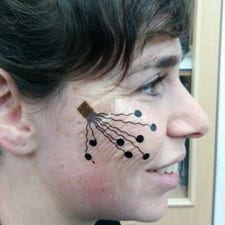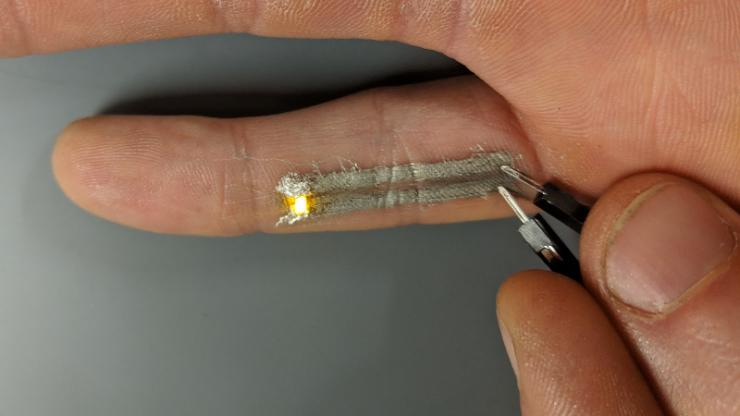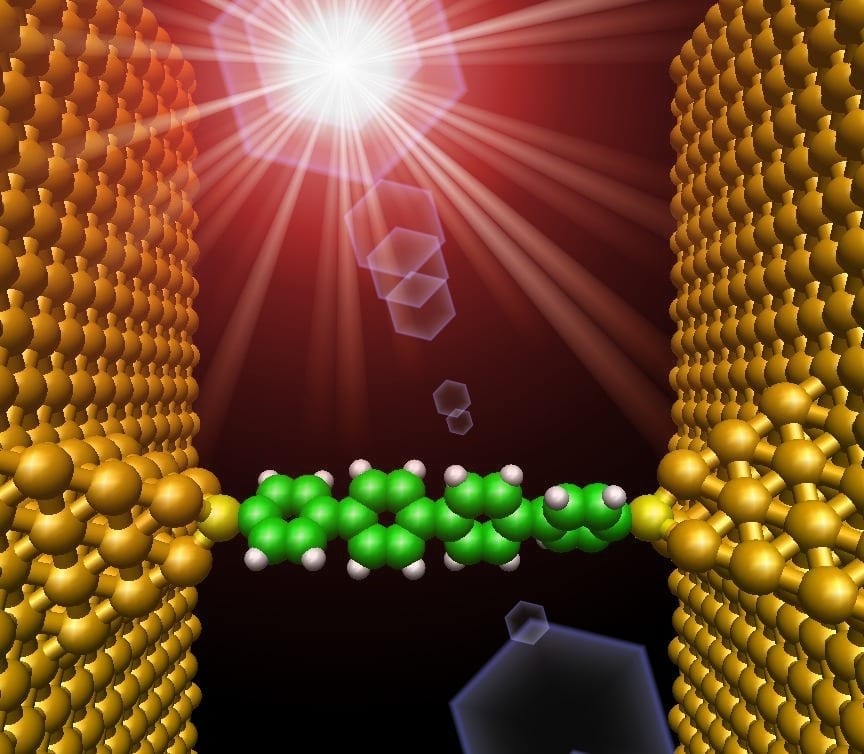
Novel skin electrode is comfortable and has endless commercial and medical applications, says TAU researcher
A new temporary “electronic tattoo” developed by Tel Aviv University that can measure the activity of muscle and nerve cells researchers is poised to revolutionize medicine, rehabilitation, and even business and marketing research.
The tattoo consists of a carbon electrode, an adhesive surface that attaches to the skin, and a nanotechnology-based conductive polymer coating that enhances the electrode’s performance. It records a strong, steady signal for hours on end without irritating the skin.
The electrode, developed by Prof. Yael Hanein, head of TAU’s Center for Nanoscience and Nanotechnology, may improve the therapeutic restoration of damaged nerves and tissue — and may even lead to new insights into our emotional life.
Prof. Hanein’s research was published last month in Scientific Reports and presented at an international nanomedicine program held at TAU.
“Stick it on and forget about it”
One major application of the new electrode is the mapping of emotion by monitoring facial expressions through electric signals received from facial muscles. “The ability to identify and map people’s emotions has many potential uses,” said Prof. Hanein. “Advertisers, pollsters, media professionals, and others — all want to test people’s reactions to various products and situations. Today, with no accurate scientific tools available, they rely mostly on inevitably subjective questionnaires.
“Researchers worldwide are trying to develop methods for mapping emotions by analyzing facial expressions, mostly via photos and smart software,” Prof. Hanein continued. “But our skin electrode provides a more direct and convenient solution.”
The device was first developed as an alternative to electromyography, a test that assesses the health of muscles and nerve cells. It’s an uncomfortable and unpleasant medical procedure that requires patients to lie sedentary in the lab for hours on end. Often a needle is stuck into muscle tissue to record its electrical activity, or patients are swabbed with a cold, sticky gel and attached to unwieldy surface electrodes.
“Our tattoo permits patients to carry on with their daily routines, while the electrode monitors their muscle and nerve activity,” said Prof. Hanein. “The idea is: stick it on and forget about it.”
Applications for rehabilitation and more
According to Prof. Hanein, the new skin electrode has other important therapeutic applications. The tattoo will be used to monitor the muscle activity of patients with neurodegenerative diseases in a study at Tel Aviv Medical Center.
“But that’s not all,” said Prof. Hanein. “The physiological data measured in specific muscles may be used in the future to indicate the alertness of drivers on the road; patients in rehabilitation following stroke or brain injury may utilize the ‘tattoo’ to improve muscle control; and amputees may employ it to move artificial limbs with remaining muscles.”
Learn more: Nanotech “Tattoo” Can Map Emotions and Monitor Muscle Activity
The Latest on: Nanotech tattoo
[google_news title=”” keyword=”Nanotech tattoo” num_posts=”10″ blurb_length=”0″ show_thumb=”left”]
via Google News
The Latest on: Nanotech tattoo
- White Fox Tattoo Studios Introduces Laser Tattoo Removal, Redefining the Art of Ink Transformation in Indianaon April 18, 2024 at 9:38 am
Their new services include complete tattoo removal, partial removal, and lightening for cover-ups. Their certified laser specialist utilizes powerful laser technology featuring the Astanza Duality, to ...
- 6 Unexpected Benefits Of Having Tattooson April 17, 2024 at 5:00 pm
Tattoos have evolved from mere body art to a deeper form of self-expression and identity. But beyond their aesthetics, tattoos offer a myriad of physical and emotional benefits. Each time you get ...
- Troops and Tattoos: A History in Inkon April 15, 2024 at 3:39 am
Amid the turmoil that Vietnam brought, troops got tattoos, in part, to find meaning in the military they were drafted into – memorial and “moto” tattoos became popular, like crossed M-16s on ...
- Ötzi the Iceman’s 61 tattoos weren’t made in the way archaeologists first thoughton April 9, 2024 at 11:11 am
His remarkably well-preserved remains, frozen beneath ice for about 5,300 years, revealed 61 tattoos inked all over his body. How and why Ötzi, perhaps the world’s most studied corpse ...
- 22 Birth Flower Tattoos to Celebrate Youon April 9, 2024 at 8:25 am
Each year brings new tattoo trends, but some styles prove they are here to stay. Floral designs, for instance, stand out as a timeless go-to for many tattoo lovers, and it's not hard to see why.
- Billie Eilish Debuts New Hip Tattoo: See What Her Fresh Ink Sayson April 5, 2024 at 10:45 am
The star gave fans a peek at the new tattoo via Instagram Stories Steve Granitz/FilmMagic; Billie Eilish/Instagram Billie Eilish is sporting some new ink. On Thursday, April 4, the 22-year-old ...
- How Ötzi the Iceman really got his tattooson April 5, 2024 at 3:30 am
An off-beat experiment has poked holes in a popular assumption about Ötzi the Iceman’s tattoos. Ötzi’s roughly 5,200-year-old body, found partly preserved and naturally mummified in the ...
- Elle King Reveals What Inspired Her New Butt Tattooon April 5, 2024 at 12:45 am
The "Ex's and Oh's" singer recently debuted a new tattoo, located on her rear, that paid tribute to some very important men in her life. "I always said I'd get my baby daddys name tattooed on my ...
- Machine Gun Kelly Shares Look at Painstaking Process Behind Blackout Tattooon April 2, 2024 at 2:51 am
Over a month after he debuted his new blackout ink—which covered a majority of the tattoos on his chest and arms, leaving only a few lines—the rapper (whose real name is Colson Baker ...
- 5 Ways Your Tattoos Reveal Who You Areon April 1, 2024 at 1:33 pm
It has been said that a tattoo is like a book, which can be read, analyzed, and interpreted for deeper meaning. These images on skin speak to the integration of body and mind, because they ...
via Bing News










